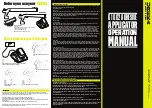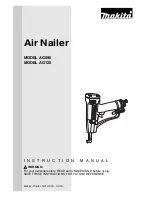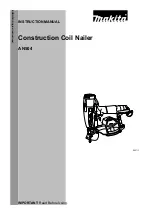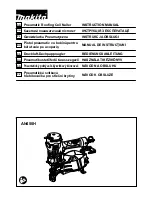
3
b) The wrench provided is for tightening screws
during "Required Daily Testing".
c) Use only identical replacement parts recom-
mended by the manufacturer.
•Use only the air tool lubricants supplied with the
tool or specified by the manufacturer.
Do not use
other lubricants; they will damage the tool. See "Ac-
cessories" for a list of recommended air tool lubricants.
AIR SOURCE
•
DANGER
Do not use oxygen, combustible
gases or bottled gases as a power
source for this tool.
The tool will explode and cause
death or serious injury.
•Never connect to an air source that is capable of
exceeding 200 psi.
Over pressurizing the tool may
result in bursting, abnormal operation, breakage of
the tool or serious injury to persons. Use only clean,
dry, regulated compressed air at the rated pressure
or within the rated pressure range as marked on the
tool. Prior to using the tool, always verify that the air
source has been adjusted to the rated air pressure or
within the rated air-pressure range. Air compressors
should comply with ANSI B19.3.
SPECIFIC SAFETY INSTRUCTIONS
FOR NAILERS
•Use air supply hoses with a minimum working
pressure rating of 200 psi.
•Use pressure regulators to limit the air pressure
supplied to the tool. Set the regulators to no more
than 120 psi.
•Install only hose couplings that will allow all pres-
sure to be removed from tool when disconnected
from the source.
If the wrong fitting is installed,
pressure may remain in the tool after disconnection,
allowing it to drive a fastener, possibly causing injury.
•Prior to each use, check workpiece contact and
trigger for correct operation.
Do not disassemble or
clamp parts of the workpiece contact, trigger, or driving
mechanism. This will cause unexpected actuation,
resulting in serious injury.
•Never point the discharge area of the tool at any
body parts or at other people.
Always assume the
tool is loaded and capable of driving a fastener.
•Do not actuate the tool unless the tool is placed
firmly against the workpiece.
If the tool is not in con-
tact with the workpiece, the fastener may be deflected
away from your target.
•Do not engage in horseplay.
The discharged fasten-
ers are projectiles capable of causing serious injury.
•When using the tool, ensure the workpiece contact
is securely placed on the workpiece.
Hold the tool
firmly and be prepared for the recoil.
•Do not remove, tamper with, or otherwise cause
the tool operating controls to become inoperable.
This will cause unexpected actuation, resulting in
serious injury.
•Do not operate a tool if any portion of the tool
operating controls is inoperable, disconnected,
altered, or not working properly.
This will cause
unexpected actuation, resulting in serious injury.
•Always keep hands and body away from discharge
area of the tool.
Never attempt to clear a jammed
workpiece contact by grasping the discharge area of
the tool. Fasteners discharged from tool can cause
serious injury if they contact hands or body.
•Do not drive fasteners close to the edge of the
workpiece.
Fasteners can slip off corners and edges
or penetrate through thin material, making them pro-
jectiles capable of causing serious injury.
•Use the tool only for the intended purpose. Do
not abuse the tool.
Do not use as a hammer, stamp
or engrave information onto parts, drop or impact the
tool or otherwise apply excess force to the tool in
use. Do not mount the tool to stands or modify it for
stationary use.
•Do not carry tool by the air hose.
Only carry the
tool by the handle with your finger off of the trigger.
•Do not use this tool without the safety warning
label in place.
If the label is damaged or missing,
contact MILWAUKEE for a free replacement.
FUNCTIONAL DESCRIPTION
1
2
3
4
5
6
7
8
14
15
11
13
10
12
16
9
1. No-mar pad
2. Toe-nail claw (not shown)
3. Workpiece contact
4. Depth of drive adjustment
5. Exhaust deflector
6. Actuation selector
7. Trigger
8. Rafter hook
9. 3/8" NPT quick connector
10. Nameplate (on top of magazine)
11. Nail stop tab
12. Extra no-mar pad storage (on back of magazine)
13. Warning label (on top of magazine)
14. Pusher
15. Pusher release button
16. Nail guide
SYMBOLOGY
Read operator's manual
Wear eye protection
Keep hands away




































